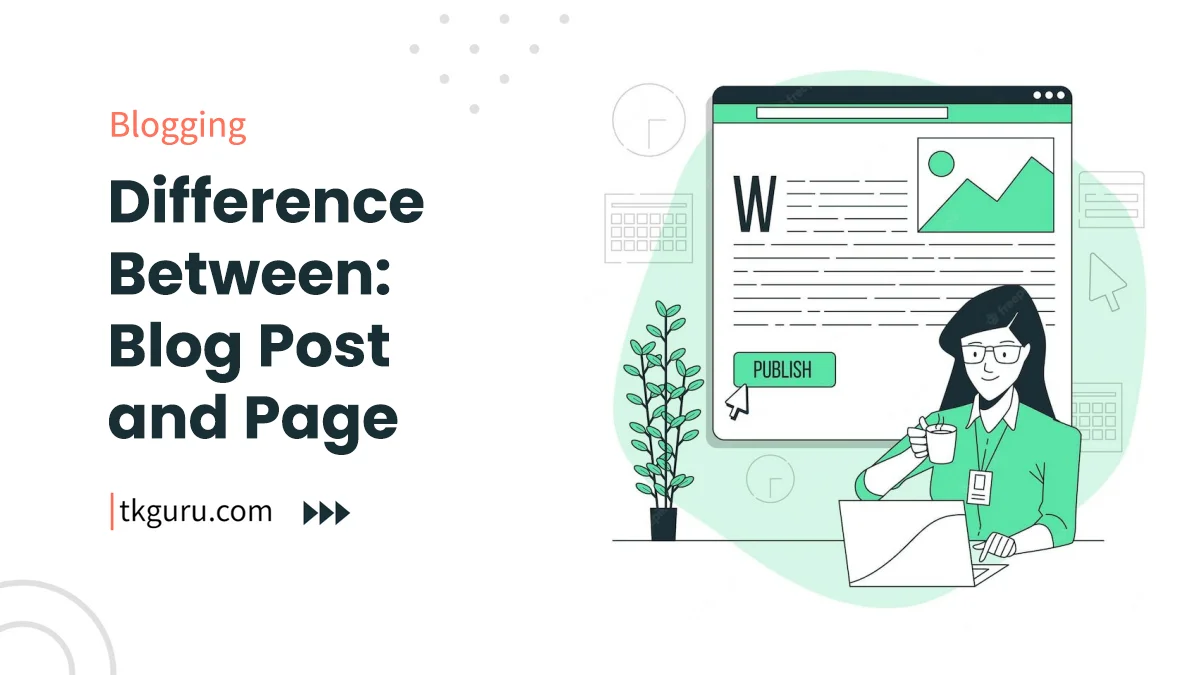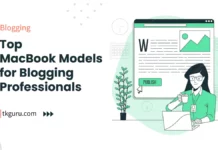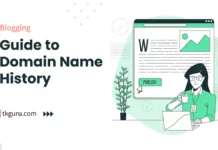Advertisements
Ratings

Difference Between a Blog Post and Page – In the digital age, websites serve as the online face of businesses, organizations, and individuals alike.
Within websites, content is a critical element, and understanding the distinction between blog posts and pages is essential for effective content management and creating a user-friendly experience.
Among the various components of websites, blog posts and pages are two fundamental content types that serve distinct purposes.
Blog posts are dynamic entries that are regularly updated with new content, while pages offer static information and serve as foundational elements.
In this comprehensive guide, we will explore the key differences between blog posts and pages, and how they each play a unique role in website development and content strategy.
Contents
- 1. Definitions and Core Purposes
- 2. Content Structure and Format
- 3. Frequency and Recency
- 4. Content Type and Purpose
- 5. Search Engine Optimization (SEO)
- 6. User Engagement and Interaction
- 7. Categories and Tags
- 8. Hierarchical Structure
- 9. Purpose in Content Marketing Strategy
- 10. Examples and Use Cases
- 11. When to Use Blog Posts vs. Pages
- 12. Comparison Table: Differences between a Blog Post and a Page
- Conclusion
- Difference Between Blog Post and Page FAQs
1. Definitions and Core Purposes
Blog Posts: Blog posts are time-sensitive entries on a website’s blog section. They are typically arranged in reverse chronological order, with the most recent post displayed first.
The primary purpose of a blog post is to deliver fresh and relevant content to the audience, often addressing specific topics, news, opinions, or trends.
Pages: Pages, on the other hand, are static content that remains relatively constant over time.
They are usually accessible from the main navigation menu and provide essential information about the website or business.
Pages are designed to offer foundational details such as about pages, contact information, product or service descriptions, and more.
2. Content Structure and Format
Blog Posts: Blog posts are characterized by their relatively shorter length compared to pages.
They are structured with a headline, introduction, body content, and often conclude with a call-to-action or discussion question.
Blog posts are highly customizable, allowing the incorporation of multimedia elements such as images, videos, and infographics to enhance engagement.
Pages: Pages are more structured in terms of layout and formatting. They generally consist of a standard header, followed by organized sections that provide specific information.
Pages tend to have a more focused and formal tone compared to the conversational style of blog posts.
3. Frequency and Recency
Blog Posts: One of the defining features of blog posts is their frequency of publication.
Websites that maintain an active blog section regularly publish new posts, keeping the content fresh and up-to-date. Blog posts often reflect recent events, trends, or developments in the industry.
Pages: Pages are relatively static and do not require frequent updates. Once created, pages remain relevant for an extended period.
These static elements provide foundational information about the website or business that remains unchanged over time.
4. Content Type and Purpose
Blog Posts: Blog posts cover a wide range of content types, including educational articles, opinion pieces, tutorials, news updates, personal stories, and more.
They offer a platform for sharing insights, expertise, and information that engages the audience.
Pages: Pages typically fulfill specific informational needs. Common types of pages include “About Us,” “Services,” “Contact,” “FAQs,” and “Privacy Policy”.
These pages offer essential details about the website’s purpose, the products or services offered, contact information, and legal information.
5. Search Engine Optimization (SEO)
Blog Posts: Blog posts are an integral part of a website’s SEO strategy. By regularly publishing fresh, relevant, and optimized content, websites can attract organic traffic, improve search engine rankings, and establish authority in their niche.
Pages: Pages also contribute to SEO by providing structured information that search engines can index.
Optimizing pages with relevant keywords and ensuring a coherent structure enhances their visibility in search engine results.
6. User Engagement and Interaction
Blog Posts: One of the unique aspects of blog posts is the engagement they foster. Readers can leave comments, share their opinions, and engage in discussions with the author and other readers. This interactive feature promotes a sense of community and active engagement.
Pages: Pages typically do not have interactive features like comments or discussion sections.
Instead, they provide information that users can consume without the need for immediate engagement.
7. Categories and Tags
Blog Posts: Blog posts are often organized using categories and tags. Categories group related posts under broader topics, while tags offer more specific descriptors. These organizational tools help users find content on specific subjects.
Pages: Pages are typically organized within the website’s navigation menu. Each page serves as a distinct section with its own set of information.
8. Hierarchical Structure
Blog Posts: Blog posts are usually presented in a linear, chronological order on the website’s blog page. While they may be categorized, the primary organization is based on publication date.
Pages: Pages can have a hierarchical structure, with parent pages and child pages. This hierarchy allows for a more organized presentation of information, ensuring users can navigate through the website easily.
9. Purpose in Content Marketing Strategy
Blog Posts: Blog posts play a pivotal role in content marketing. They enable businesses to share valuable information, establish authority, and attract a wider audience.
By addressing user queries, blog posts contribute to brand awareness and customer engagement.
Pages: Pages serve as foundational elements that provide essential information about the business, brand, or organization. They contribute to establishing credibility and conveying important details to visitors.
10. Examples and Use Cases
Blog Posts Examples:
- How-To Guides: “10 Steps to Mastering Digital Photography.”
- News Updates: “Breaking News: Major Tech Company Unveils New Product.”
- Opinion Pieces: “The Future of Electric Cars: An Expert’s View.”
- Tutorial Posts: “A Comprehensive Guide to Starting a Home Garden.”
- Listicles: “Top 10 Must-Try Recipes for a Healthy Lifestyle.”
Pages Examples:
- About Us Page: Providing information about the company’s history, values, and mission.
- Services Page: Detailing the range of products or services offered by the business.
- Contact Page: Offering contact information and a form for visitors to reach out.
- FAQ Page: Answering common questions about the business, products, or services.
- Privacy Policy Page: Outlining the website’s privacy practices and data handling.
11. When to Use Blog Posts vs. Pages
Use Blog Posts When:
- Sharing timely information, news, or updates.
- Providing educational content and valuable insights.
- Creating engaging and shareable content.
- Establishing authority in your niche.
- Fostering user engagement and interaction.
Use Pages When:
- Offering foundational information about your business.
- Presenting static details that don’t change frequently.
- Providing essential information for visitors.
- Structuring content hierarchically for easy navigation.
- Conveying legal, privacy, or policy-related information.
12. Comparison Table: Differences between a Blog Post and a Page
Here’s a comparison table highlighting the differences between a blog post and a page:
| Aspect | Blog Post | Page |
|---|---|---|
| Content Type | Dynamic, regularly updated entries | Static, consistent information |
| Arrangement | Reverse chronological order | Typically organized in the website’s navigation |
| Purpose | Deliver fresh and relevant content | Provide foundational information |
| Length | Relatively shorter | Varied, can be longer or shorter |
| Structure | Headline, introduction, body, CTA | Standard header, organized sections |
| Engagement | Promotes discussions and interactions | Information consumption, less interactive |
| Frequency | Frequently updated | Remains relatively constant over time |
| Content Types | Articles, opinions, news, tutorials, stories | About Us, Services, Contact, FAQs, Privacy Policy |
| SEO Impact | Improves rankings with fresh, optimized content | Enhances indexability and structured data |
| Interaction | Comments, shares, discussions | No interactive features |
| Organization | Categories and tags | Organized within the navigation menu |
| Hierarchical Structure | Linear order based on publication date | Parent and child pages for better organization |
| Marketing Role | Establishes authority, attracts audience | Provides essential business information |
Conclusion
In the ever-evolving world of digital content, understanding the differences between blog posts and pages is crucial for effective website development and content strategy.
Blog posts bring freshness, engagement, and SEO benefits, while pages provide foundational information and structure.
By strategically utilizing both types of content, websites can create a comprehensive online presence that caters to users’ diverse needs and expectations.
As you navigate the realm of website creation and content management, remember that each component plays a unique role in delivering a cohesive and user-friendly experience.
Difference Between Blog Post and Page FAQs
What is the primary difference between a blog post and a page on a website?
The main difference is in their content and purpose. A blog post is typically used for time-sensitive, regularly updated content, such as articles, news, and stories. A page, on the other hand, is static and used for permanent, essential information like an About Us or Contact page.
How often should I create blog posts compared to pages on my website?
Blog posts are typically created more frequently, often several times a week or month, to provide fresh and timely content. Pages, on the other hand, are created less frequently and are designed to remain relatively unchanged over time.
Can you give examples of content suitable for a blog post and a website page?
Blog posts are suitable for articles, news updates, product reviews, and time-sensitive content. Website pages are ideal for static information like your Home, About Us, Contact, Services, and FAQ pages.
How are blog posts and website pages organized and displayed on a website?
Blog posts are usually organized in reverse chronological order on a blog or news section of your site, with the most recent posts displayed at the top. Website pages, on the other hand, are typically accessible through the site's main navigation menu and remain relatively fixed.
Do blog posts and website pages have different SEO considerations?
Yes, blog posts and website pages may have slightly different SEO strategies. Blog posts often target specific keywords and may benefit from regular content updates, while website pages aim for consistent, stable rankings and may target broader keywords or location-specific SEO tactics.
| Web Hosting | Website |
| WordPress | Google Adsense |
| SEO | Affiliate Marketing |
| Blogging | YouTube |
Recent Posts:
- Windows vs Mac: Choosing the Ideal Laptop for Your Needs
- 10 Best Budget Friendly Laptops for Bloggers with Impressive Performance
- Top MacBook Models for Blogging Professionals
- 10 Best Laptops for Content Creators in 2023
Related Tags:






